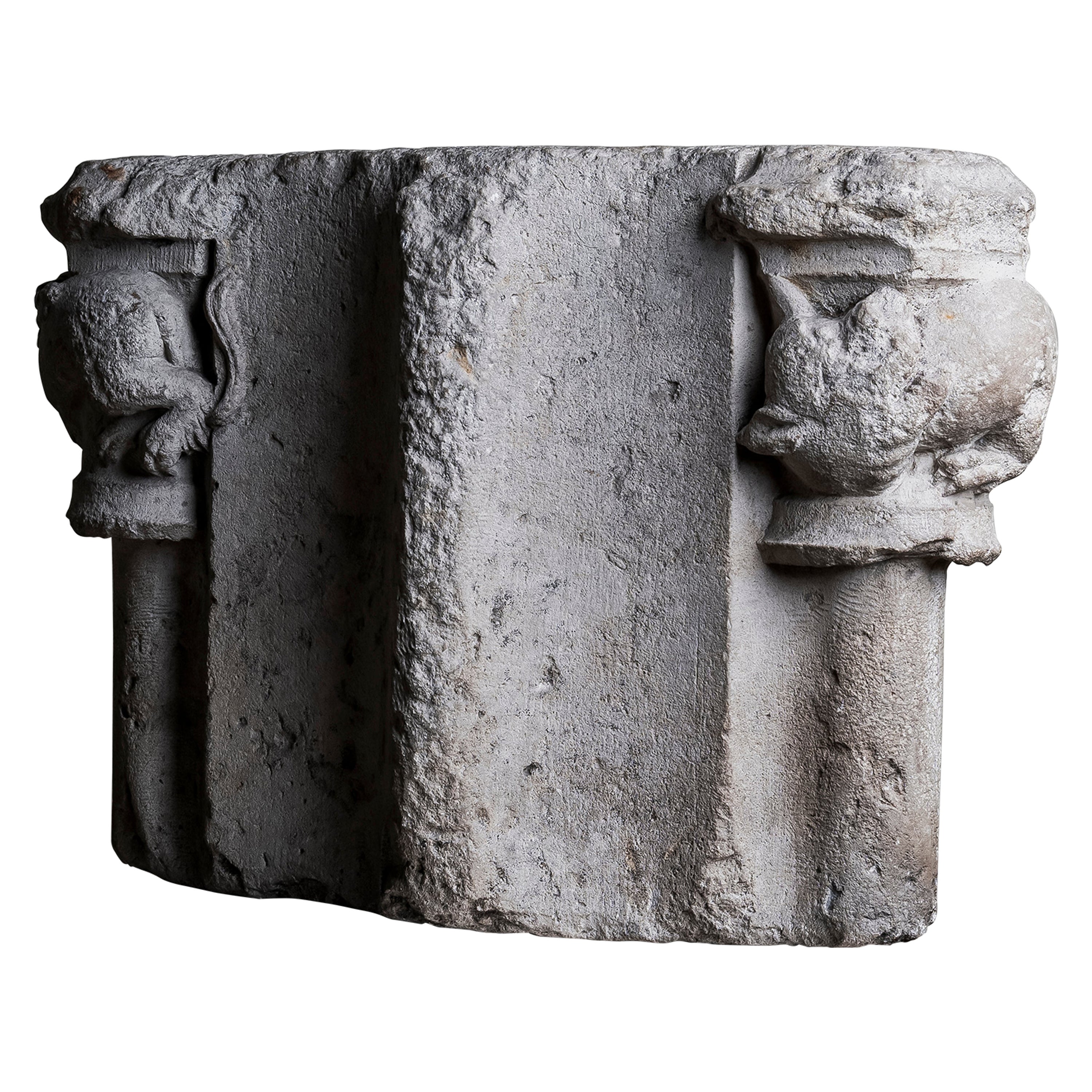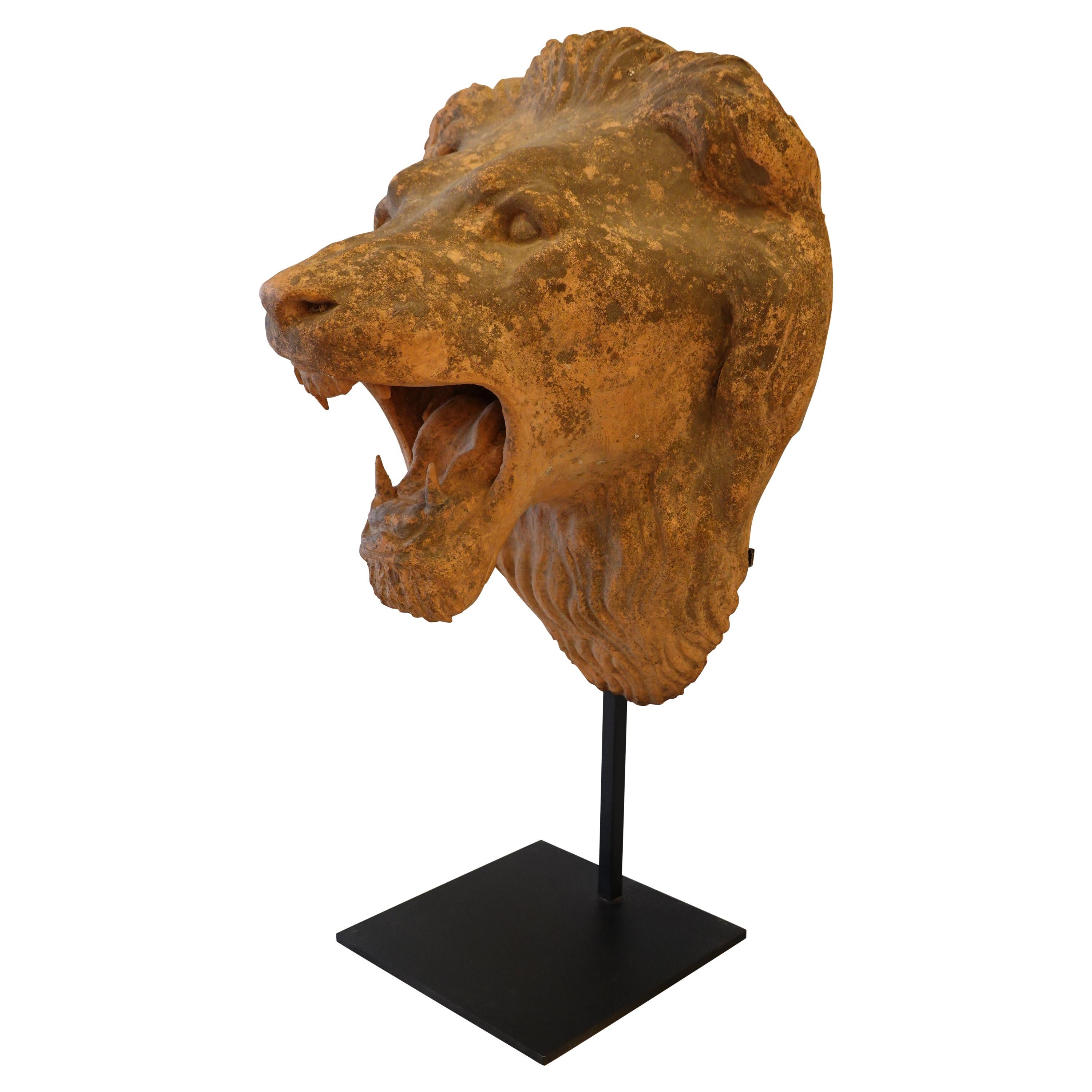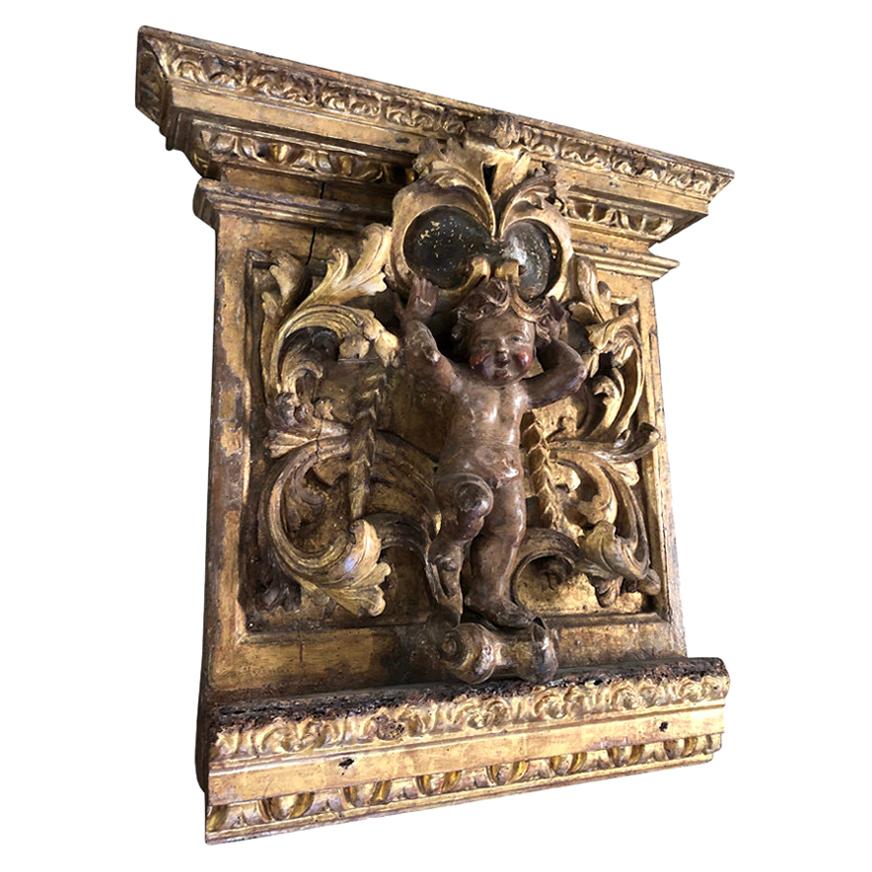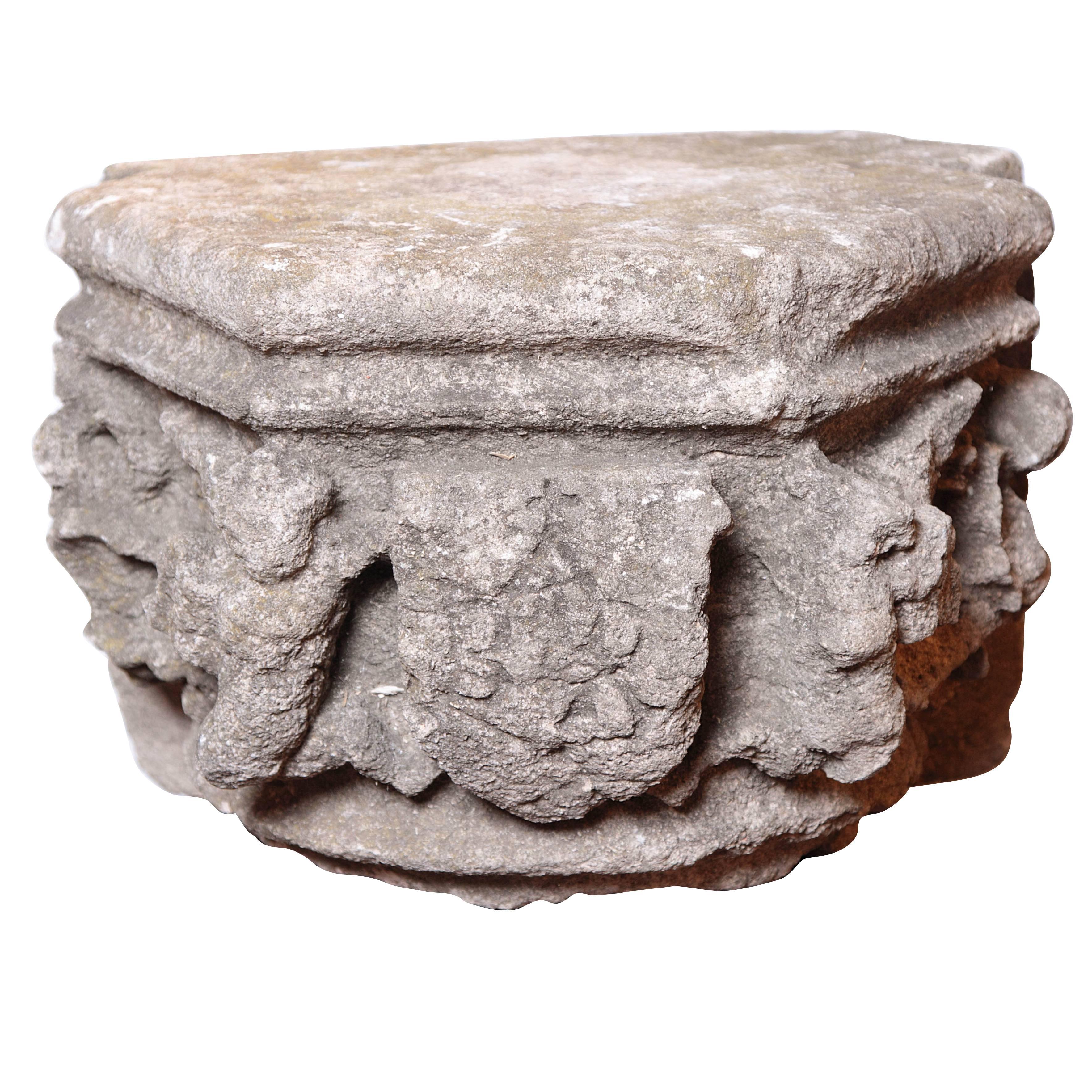Items Similar to Rare Romanesque Capital Representing Daniel in the Lion’s Den, 12th Century
Want more images or videos?
Request additional images or videos from the seller
1 of 5
Rare Romanesque Capital Representing Daniel in the Lion’s Den, 12th Century
About the Item
Engaged Romanesque capital representing Daniel in the Lion’s den
France, 12th century
Limestone
38 x 29 x 18 cm
Provenance : Private collection Brugge, Belgique
This intriguant and rare engaged capital is decorated in two sides with stylized lions around a human bust; the base consiste of a simple roll moulding. The capital is carved only in two sides suggesting that it would have originally been in a corner, where it may have supported a wooden roof or an arch. The fine carving of this piece survives in a very good condition.
The low relief figures of two confronting and opposing lions are stylized but interpreted with an elegant and ornamental design, with incised details of the tail and the mane. The three wild animals are represented in rampant position with long manes and tails ending in a tassel. The symmetrical back-to-back arrangement of the beasts resembles the decorative motifs of textiles imported from the islamic or Byzantine world. During the Middle Ages, the artistic connection was possible through Mediterranean trade routes. Emile Mâle argued that many of the animal motifs, and prominent among them most lions, were borrowed from Eastern textile art, which was well known in Medieval Europe.
The faces of all three creatures are carved with cat-shaped ears, circular incised eyes with drilled pupils and enrolled incised tails. The relief follow a symmetrical compositional formula, that was favored in Romanesque sculpture.
The iconography, Showing a human figure flanked by lions, is a common theme in Romanesque churches and was one of the most Ancient images known to man, emerging out of Sumeria in the third millennium BC.
It probably represents the history of Daniel in the Lion’s Den which was one of the most iconic scene in the whole Romanesque canon. A capital showing the same motif is preserved at Saint Pierre de Mossac.
In both capital, the half-figure of Daniel occupied the central position and the lions surrounds him in symmetrical position.
The story is taken from Chapter six of the Book of Daniel. The Old Testament recounts how the Persian king Darius I "The Great" (550–486 BC) condemned the devout and steadfast Daniel to spend the night in a lions den for worshipping God rather than him. The following morning, after the stone sealing the entrance was rolled away, the astonished Persians saw Daniel, very much alive, giving thanks to God for keeping him safe overnight: "Then said Daniel unto the king :« O king, live for ever. My God hath sent his angel, and hath shut the lions mouths, that they have not hurt me: forasmuch as before him innocency was found in me; and also before thee, O king, have I done no hurt." (Daniel 6:21–22)
For theologians, Daniel's miraculous survival in the cave symbolized the resurrection of Christ from his tomb, and the promise of God's protection to those of unwavering faith.
The Daniel legend found its way into early funerary prayers. Depictions were a feature of the first Christian art of the Roman catacombs and were widely used on sarcophagi of Late Antiquity. Hippolytus of Rome was the author of the first commentary on Daniel just after the turn of the third century. Drawing on the notion of Daniel, who by his faith in God evaded death at the hands of the lions, Hippolytus found parallels with the Resurrection. Daniel, he equated with Adam as a precursor of Christ and the lions represented Death overcome.
The Book of Daniel continued to be the subject of numerous commentaries from authors including Jerome and Ambrose of Milan and throughout the middle ages in texts by the Benedictine monks Raban Maur and Honorius of Autun.
The Den was an image of Hell, wrote Didymus the Blind in his fourth century Commentary on Zechariah: “Ask yourself if the Den without water is not the Hell of the impious and sinners”. With the lions symbolizing Death, a common reading was to equate Daniel’s survival with Christ’s triumph over Death. Thus the image read as a descent into Hell and a resurrection and therefore a prefiguration of Christ’s Passion and Resurrection.
Ultimately the image of Daniel in the Lion’s Den was seen as a symbolic representation of Paradise. Daniel was guarded by the lions. Aprahat wrote that the lions extended their paws to cushion Daniel’s fall into the Den. Ambrose and Paulinus of Nola echoed this notion.
The person of Daniel was also taken to represent the Christian believer whose own death and resurrection were implicit in the Daniel legend.
This broad range of allegorical readings of the narrative can be found represented in the rich variety of the depictions in Romanesque sculpture.
Bibliography:
R. B. Green, Daniel in the Lion’s Den as an exemple of Romanesque typology, The University of Chicago, Dissertation, 1948
Emile Mâle, Religious art in France. The Twelfth century, Princeton 1978
Tina Negus. Daniel in the Den of Lions: early medieval carvings and their origins. Journal of Ethnological Studies. Vol.44
- Dimensions:Height: 14.97 in (38 cm)Width: 11.42 in (29 cm)Depth: 7.09 in (18 cm)
- Style:Medieval (Of the Period)
- Materials and Techniques:
- Place of Origin:
- Period:
- Date of Manufacture:12th Century
- Condition:Wear consistent with age and use.
- Seller Location:Bruxelles, BE
- Reference Number:1stDibs: LU6666233676162
About the Seller
5.0
Vetted Seller
These experienced sellers undergo a comprehensive evaluation by our team of in-house experts.
1stDibs seller since 2022
6 sales on 1stDibs
Typical response time: 7 hours
- ShippingRetrieving quote...Ships From: Bruxelles, Belgium
- Return PolicyA return for this item may be initiated within 3 days of delivery.
More From This SellerView All
- Rare Romanesque Capital Depicting Four Africans, Apulia, 13th CenturyLocated in Bruxelles, BELarge stone capital carved on each side in strong relief. The basket is covered with two crowns of vertical acanthus leaves which sprout from the astragal and fill the space between ...Category
Antique 15th Century and Earlier Italian Medieval Architectural Elements
MaterialsStone
- Double Romanesque Capital, France, 13th CenturyLocated in Bruxelles, BEDouble romanesque capital decorated with two fantastic animals France, 13th century Measures: 26,5 x 38,5 x 14,5 cm. This rare double cap...Category
Antique 15th Century and Earlier French Medieval Architectural Elements
MaterialsStone
- Gothic Stone Fragment Representing Vine Leaves, France, 15th CenturyLocated in Bruxelles, BEGothic architectural fragment representing vine leaves France, 15th century Sandstone H 21 x 21 x 17 cm mounted on a modern metal pe...Category
Antique 15th Century and Earlier French Gothic Architectural Elements
MaterialsLimestone
- Romanesque capital with sirens - France 13th centuryLocated in Bruxelles, BERare romanesque capital with sirens France, XIII century Limestone 25 x 28 x 22 cm This finely carved Romanesque capital, executed in high relief from limestone, features four hyb...Category
Antique 15th Century and Earlier French Medieval Figurative Sculptures
MaterialsStone
- Large Hexagonale Base of Pilaster in Burgundy Stone, Burgundy, 15th CenturyLocated in Bruxelles, BELarge base of molded hexagonal pilaster in burgundy stone carved with vines, grapes and rosettes in high relief. Burgundy, 15th century 28 x 63 x 30 cm Provenance : collection De...Category
Antique 15th Century and Earlier French Gothic Architectural Elements
MaterialsStone
- Gothic Capital with Foliate Decoration, 13th CenturyLocated in Bruxelles, BEGothic capital with foliate decoration France, limestone 13th century 16.5 x 17 x 12.5 cm The leaves are organically arranged around the core of...Category
Antique 15th Century and Earlier French Medieval Architectural Elements
MaterialsLimestone
You May Also Like
- French Terracotta Lion's Head on Custom Iron StandLocated in Pembroke, MAThis French terracotta lion's mask was originally an element of a 19th century fountain with water jetting from its mouth. This garden piece is now mounted on a custom iron, making i...Category
Antique Late 19th Century French Neoclassical Animal Sculptures
MaterialsIron
- 17th Century French Capital FragmentLocated in Atlanta, GAAn outstanding and exquisite 17th century French capital to a pilaster. Expertly carved from wood with a wonderful cherub stunningly finished in water gilding and polychrome. A excep...Category
Antique 17th Century French Architectural Elements
MaterialsWood
- Rare 16th Century Architectural Stone Capital from FranceLocated in Dallas, TXThis rare fragment was salvaged from an entryway on a building in Fontvieille, near the city ancient Arles, France. There is a worn and carved center cartouche depicting a very small...Category
Antique 16th Century French Gothic Architectural Elements
MaterialsStone
- Romanesque Hand Carved Limestone Capital from SpainLocated in Vulpellac, GironaBeautiful Romanesque hand carved Capital with two faces figures - one is missing - and two round spheres. A unique piece for your collection. Beautiful Spanish Romanesque hand ca...Category
Antique 15th Century and Earlier Spanish Other Architectural Elements
MaterialsLimestone
- 12th Century Corinthian Limestone CapitalLocated in Beuzevillette, FRBeautiful antique capital carved in a 12th century limestone. It is decorated with acanthus leaves, as required by the Corinthian architectural traditi...Category
Antique 15th Century and Earlier Pedestals and Columns
MaterialsLimestone
- 19th Century Matched Pair of Recumbent Carved Mahogany LionsLocated in London, GBRecumbent carved mahogany lions We are proud to offer a highly decorative matched pair of hand carved recumbent carved mahogany lion figures. These 2 examples show a classical decor...Category
Antique 1850s British Early Victorian Animal Sculptures
MaterialsMahogany





